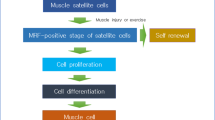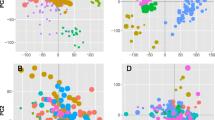Abstract
The phenotypic differences among Duchenne muscular dystrophy patients, mdx mice, and mdx5cv mice suggest that despite the common etiology of dystrophin deficiency, secondary mechanisms have a substantial influence on phenotypic severity. The differential response of various skeletal muscles to dystrophin deficiency supports this hypothesis. To explore these differences, gene expression profiles were generated from duplicate RNA targets extracted from six different skeletal muscles (diaphragm, soleus, gastrocnemius, quadriceps, tibialis anterior, and extensor digitorum longus) from wild-type, mdx, and mdx5cv mice, resulting in 36 data sets for 18 muscle samples. The data sets were compared in three different ways: (1) among wild-type samples only, (2) among all 36 data sets, and (3) between strains for each muscle type. The molecular profiles of soleus and diaphragm separate significantly from the other four muscle types and from each other. Fiber-type proportions can explain some of these differences. These variations in wild-type gene expression profiles may also reflect biomechanical differences known to exist among skeletal muscles. Further exploration of the genes that most distinguish these muscles may help explain the origins of the biomechanical differences and the reasons why some muscles are more resistant than others to dystrophin deficiency.





Similar content being viewed by others
References
Brazma A, Hingamp P, Quackenbush J, et al. (2001) Minimum information about a microarray experiment (MIAME)-toward standards for microarray data. Nat Genet 29: 365-371
Bulfield G, Siller WG, Wight PA, Moore KJ (1984) X chromosome-linked muscular dystrophy (mdx) in the mouse. Proc Natl Acad Sci U S A 81: 1189-1192
Burkholder TJ, Fingado B, Baron S, Lieber RL (1994) Relationship between muscle fiber types and sizes and muscle architectural properties in the mouse hindlimb. J Morphol 221: 177-190
Butte AJ, Ye J, Haring HU, Stumvoll M, White MF, et al. (2001) Determining significant fold differences in gene expression analysis. Pac Symp Biocomput 6– 17
Campbell WG, Gordon SE, Carlson CJ, et al. (2001) Differential global gene expression in red and white skeletal muscle. Am J Physiol Cell Physiol 280: C763-C768
Chapman VM, Miller DR, Armstrong D, Caskey CT (1989) Recovery of induced mutations for X chromosome-linked muscular dystrophy in mice. Proc Natl Acad Sci U S A 86: 1292-1296
Chen YW, Zhao P, Borup R, Hoffman EP (2000) Expression profiling in the muscular dystrophies: identification of novel aspects of molecular pathophysiology. J Cell Biol 151: 1321-1336
Danko I, Chapman V, Wolff JA (1992) The frequency of revertants in mdx mouse genetic models for Duchenne muscular dystrophy. Pediatr Res 32: 128-131
Deconinck N, Rafael JA, Beckers-Bleukx G, Kahn D, Deconinck AE, et al. (1998) Consequences of the combined deficiency in dystrophin and utrophin on the mechanical properties and myosin composition of some limb and respiratory muscles of the mouse. Neuromuscul Disord 8: 362-370
Durbeej M, Campbell KP (2002) Muscular dystrophies involving the dystrophin-glycoprotein complex: an overview of current mouse models. Curr Opin Genet Dev 12: 349-361
Eisen MB, Spellman PT, Brown PO, Botstein D (1998) Cluster analysis and display of genome-wide expression patterns. Proc Natl Acad Sci U S A 95: 14863-14868
Ervasti JM, Campbell KP (1991) Membrane organization of the dystrophin-glycoprotein complex. Cell 66: 1121-1131
Ervasti JM, Ohlendieck K, Kahl SD, et al. (1990) Deficiency of a glycoprotein component of the dystrophin complex in dystrophic muscle. Nature 345: 315-319
Greenberg SA, Sanoudou D, Haslett JN, et al. (2002) Molecular profiles of inflammatory myopathies. Neurology 59: 1170-1182
Haslett JN, Kunkel LM (2002) Microarray analysis of normal and dystrophic skeletal muscle. Int J Dev Neurosci 20: 359-365
Haslett JN, Sanoudou D, Kho AT, et al. (2002) Gene expression comparison of biopsies from Duchenne muscular dystrophy (DMD) and normal skeletal muscle. Proc Natl Acad Sci U S A 99: 15000-15005
Haslett JN, Sanoudou D, Kho AT, et al. (2003) Gene expression profiling of Duchenne muscular dystrophy skeletal muscle. Neurogenetics 4: 163-171
Hoffman EP, Gorospe JR (1991) The animal models of Duchenne muscular dystrophy: windows on the pathophysiological consequences of dystrophin deficiency. In Ordering the membrane cytoskeleton trilayer, Mooseker MT, Morrow J, eds. (New York: Academic), pp 113-154
Hoffman EP, Brown RH Jr, Kunkel LM (1987) Dystrophin: the protein product of the Duchenne muscular dystrophy locus. Cell 51: 919-928
Kaminski HJ, al-Hakim M, Leigh RJ, et al. (1992) Extraocular muscles are spared in advanced Duchenne dystrophy. Ann Neurol 32: 586-588
Karpati G, Carpenter S (1986) Small-caliber skeletal muscle fibers do not suffer deleterious consequences of dystrophic gene expression. Am J Med Genet 25: 653-658
Khurana TS, Prendergast RA, Alameddine HS, et al. (1995) Absence of extraocular muscle pathology in Duchenne’s muscular dystrophy: role for calcium homeostasis in extraocular muscle sparing. J Exp Med 182: 467-475
Koenig M, Monaco AP, Kunkel LM (1988) The complete sequence of dystrophin predicts a rod-shaped cytoskeletal protein. Cell 53: 219-226
Matsumura K, Ervasti JM, Ohlendieck K, et al. (1992) Association of dystrophin-related protein with dystrophin-associated proteins in mdx mouse muscle. Nature 360: 588-591
McArdle A, Edwards RH, Jackson MJ (1994) Time course of changes in plasma membrane permeability in the dystrophin-deficient mdx mouse. Muscle Nerve 17: 1378-1384
Moens P, Baatsen PH, Marechal G (1993) Increased susceptibility of EDL muscles from mdx mice to damage induced by contractions with stretch. J Muscle Res Cell Motil 14: 446-451
Noguchi S, Tsukahara T, Fujita M, et al. (2003) cDNA microarray analysis of individual Duchenne muscular dystrophy patients. Hum Mol Genet 12: 595-600
Petrof BJ, Stedman HH, Shrager JB, et al. (1993) Adaptations in myosin heavy chain expression and contractile function in dystrophic mouse diaphragm. Am J Physiol 265: C834-C841
Porter JD, Khanna S, Kaminski HJ, et al. (2002) A chronic inflammatory response dominates the skeletal muscle molecular signature in dystrophin-deficient mdx mice. Hum Mol Genet 11: 263-272
Porter JD, Baker RS (1996) Muscles of a different “color”: the unusual properties of the extraocular muscles may predispose or protect them in neurogenic and myogenic disease. Neurology 46: 30-37
Porter JD, Merriam AP, Khanna S, et al. (2003) Constitutive properties, not molecular adaptations, mediate extraocular muscle sparing in dystrophic mdx mice. FASEB J 17: 893-895
Porter JD, Merriam AP, Leahy P, et al. (2004) Temporal gene expression profiling of dystrophin-deficient (mdx) mouse diaphragm identifies conserved and muscle group-specific mechanisms in the pathogenesis of muscular dystrophy. Hum Mol Genet 13: 257-269
Rouger K, Le Cunff M, Steenman M, et al. (2002) Global/temporal gene expression in diaphragm and hindlimb muscles of dystrophin-deficient (mdx) mice. Am J Physiol Cell Physiol 283: C773-C784
Ryder-Cook AS, Sicinski P, Thomas K, et al. (1988) Localization of the mdx mutation within the mouse dystrophin gene. EMBO J 7: 3017-3021
Sanoudou D, Haslett JN, Kho AT, et al. (2003) Expression profiling reveals altered satellite cell numbers and glycolytic enzyme transcription in nemaline myopathy muscle. Proc Natl Acad Sci U S A 100: 4666-4671
Sicinski P, Geng Y, Ryder-Cook AS, et al. (1989) The molecular basis of muscular dystrophy in the mdx mouse: a point mutation. Science 244: 1578-1580
Stedman HH, Sweeney HL, Shrager JB, et al. (1991) The mdx mouse diaphragm reproduces the degenerative changes of Duchenne muscular dystrophy. Nature 352: 536-539
Sturn A, Quackenbush J, Trajanoski Z (2002) Genesis: cluster analysis of microarray data. Bioinformatics 18: 207-208
Talmadge RJ, Otis JS, Rittler MR, Garcia MD, Spencer SR, et al. (2004) Calcineurin activation influences muscle phenotype in a muscle-specific fashion. BMC Cell Biol 5: 28
Tamayo P, Slonim D, Mesirov J, et al. (1999) Interpreting patterns of gene expression with self-organizing maps: methods and application to hematopoietic differentiation. Proc Natl Acad Sci U S A 96: 2907-2912
Tkatchenko AV, Le Cam G, Leger JJ, Dechesne CA (2000) Large-scale analysis of differential gene expression in the hindlimb muscles and diaphragm of mdx mouse. Biochim Biophys Acta 1500: 17-30
Tseng BS, Zhao P, Pattison JS, et al. (2002) Regenerated mdx mouse skeletal muscle shows differential mRNA expression. J Appl Physiol 93: 537-545
Yoshida M, Ozawa E (1990) Glycoprotein complex anchoring dystrophin to sarcolemma. Journal of Biochemistry 108: 748-752
Zhao Q, Kho A, Kenney AM, et al. (2002) Identification of genes expressed with temporal-spatial restriction to developing cerebellar neuron precursors by a functional genomic approach. Proc Natl Acad Sci U S A 99: 5704-5709
Acknowledgments
The authors thank Marielle Thorne for her assistance. This work was supported by NIH grants P01 NS40828-01A1 (ISK, AHB, LMK), R01 AR44349 (AHB), U01 HL066582-01 (ISK), and K08 NS048180 (PBK), the Muscular Dystrophy Association (PBK, AHB, LMK), the Bernard F. and Alva B. Gimbel Foundation (LMK), the Joshua Frase Foundation (AHB, LMK), and the William Randolph Hearst Foundation (PBK).
Author information
Authors and Affiliations
Corresponding author
Additional information
Judith N. Haslett, Peter B. Kang These authors contributed equally to this work.
Electronic Supplementary Material
Rights and permissions
About this article
Cite this article
Haslett, J.N., Kang, P.B., Han, M. et al. The influence of muscle type and dystrophin deficiency on murine expression profiles. Mamm Genome 16, 739–748 (2005). https://doi.org/10.1007/s00335-005-0053-8
Received:
Accepted:
Published:
Issue Date:
DOI: https://doi.org/10.1007/s00335-005-0053-8




